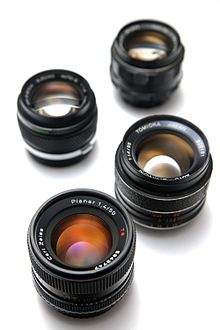- Normal lens
-
In photography and cinematography a normal lens is a lens that reproduces perspective that generally looks "natural" to a human observer under normal viewing conditions, as compared with lenses with longer or shorter focal lengths which produce an expanded or contracted field of view. Lenses of shorter focal length are called wide-angle lenses, while longer-focal-length lenses are referred to as long-focus lenses[1] (with the most common of that type being the telephoto lenses).
A lens with a focal length about equal to the diagonal size of the film or sensor format is known as a normal lens; its angle of view is similar to the angle subtended by a large-enough print viewed at a typical viewing distance equal to the print diagonal;[2] this angle of view is about 53° diagonally.
Contents
Typical normal focal lengths for different formats
Film still
Standard normal lenses for various film formats for photography are:
Film format Image dimensions Image diagonal Normal lens focal length 9.5 mm Minox 8 × 11 mm 13.6 mm 15 mm Half-frame 24 × 18 mm 30 mm 30 mm APS C 16.7 × 25.1 mm 30.1 mm 28 mm, 30 mm 135, 35mm 24 × 36 mm 43.3 mm 45 mm, 50 mm 120/220, 6 × 4.5 (645) 56 × 42 mm 71.8 mm 75 mm 120/220, 6 × 6 56 × 56 mm 79.2 mm 80 mm 120/220, 6 × 7 56 × 68 mm 88.1 mm 90 mm 120/220, 6 × 9 56 × 84 mm 101.0 mm 105 mm 120/220, 6 × 12 56 × 112 mm 125.0 mm 120 mm large format 4 × 5 sheet film 93 × 118 mm (image area) 150.2 mm 150 mm large format 5 × 7 sheet film 120 × 170 mm (image area) 208.0 mm 210 mm large format 8 × 10 sheet film 194 × 245 mm (image area) 312.5 mm 300 mm For a 35 mm camera with a diagonal of 43 mm, the most commonly used normal lens is 50 mm, but focal lengths between about 40 and 58 mm are also considered normal. The 50 mm focal length was chosen by Oskar Barnack, the creator of the Leica camera.
Note that the angle of view depends on the aspect ratio as well; a "normal" lens on 35mm does not have the same view as a "normal" lens on 645, for example.
Digital still
In digital photography, the sensor "type" is not the sensor diameter:
- (*) refers to TV tube diameters that were standards in the 50s. The normal lens focal length is roughly 2/3 of the TV tube diameter.
- (**) this is a mathematical calculation because most of the cameras are equipped with zoom lenses.
Sensor type TV-tube diameter * Image dimensions Image diagonal Normal lens focal length ** 1/3.6" 7.1 mm 4.0 × 3.0 mm 5.0 mm 5 mm 1/3.2" 7.9 mm 4.5 × 3.4 mm 5.7 mm 5.7 mm 1/3" 8.5 mm 4.8 × 3.6 mm 6.0 mm 6 mm 1/2.7" 9.4 mm 5.4 × 4.0 mm 6.7 mm 6.7 mm 1/2.5" 10.2 mm 5.8 × 4.3 mm 7.2 mm 7 mm 1/2" 12.7 mm 6.4 × 4.8 mm 8.0 mm 8 mm 1/1.8" 14.1 mm 7.2 × 5.3 mm 8.9 mm 9 mm 1/1.7" 14.9 mm 7.6 × 5.7 mm 9.5 mm 9.5 mm 2/3" 16.9 mm 8.8 × 6.6 mm 11.0 mm 11 mm 1" 25.4 mm 12.8 × 9.6 mm 16.0 mm 16 mm Four Thirds[3] 33.9 mm 17.3 × 13 mm[4] 21.63 mm 22 mm 4/3" 33.9 mm 18.0 × 13.5 mm 22.5 mm 23 mm APS-C 45.7 mm 22.7 × 15.1 mm 27.3 mm 27 mm DX n/a 23.7 × 15.8 28.4 mm 28 mm FF (35 mm film) n/a 36 × 24 mm 43.3 mm 50 mm (6 × 5 cm) n/a 49.0 × 36.7 mm 61.2 mm Cinema
In cinematography, a focal length roughly equivalent to twice the diagonal of the image projected within the camera is considered normal, since movies are typically viewed from a distance of about twice the screen diagonal.
Film format Image dimensions Image diagonal Normal lens focal length Standard 8 3.7 × 4.9 mm 6.11 mm 12–15 mm Single-8 (FUJI) 4.2 × 6.2 mm 7.5 mm 15–17 mm Super-8 4.2 × 6.2 mm 7.5 mm 15–17 mm 9.5 mm 6.5 × 8.5 mm 10.7 mm 20 mm 16 mm 7.5 × 10.3 mm 12.7 mm 25 mm 35 mm 18.0 × 24.0 mm 30.0 mm 60 mm 35 mm, sound 16.0 × 22.0 mm 27.2 mm 50 mm 65 mm 70 mm 52.6 × 23.0 mm 57.4 mm See also
References
- ^ Bruce Warren, Photography, page 71
- ^ Leslie D. Stroebel (1999), View Camera Technique, Focal Press, ISBN 0240803450, http://books.google.com/?id=71zxDuunAvMC&pg=PA136&dq=appear-normal+focal-length-lens+print-size+diagonal+viewer+distance
- ^ The Four Thirds Standard, Four Thirds Consortium, 2008, http://www.four-thirds.org/en/about/standard.html, retrieved 2009-04-17
- ^ No more compromises: the Four Thirds standard, Olympus Europa, http://www.olympus-europa.com/consumer/dslr_7045.htm, retrieved 2009-04-17
Categories:- Photographic lenses
Wikimedia Foundation. 2010.

